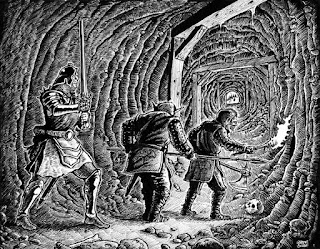 |
| (William McAusland) |
These kind of adventures have been around since the very beginning of roleplaying games, and they've remained popular in all the decades since. Dungeons usually work like this:
- Go into a twisty network of rooms and passages, all alike.
- Avoid/solve traps and other obstacles to movement.
- Fight monsters.
- Get loot.
It's a simple structure, which is both good and bad. You probably don't want to ask too many questions (like what these monsters eat when they can't get adventurer). But the simple format offers several clear types of fun:
- Mapping and exploring an unknown place.
- Thinking of clever ways to solve an obstacle.
- Struggling against a killable adversary when death is on the line.
- Being rewarded for your efforts.
 |
| (Josh Burnett) |
Dungeon crawls also constrain the adventure, providing both structure and challenge:
- The network of rooms and passages limits the paths you can take.
- A traditional dungeon crawler provides a gradient of difficulty, with the easier monsters at the start and the scariest ones at the end.
- Being underground in a dangerous makes limited resources a challenge of its own.
 |
| (Jim Holloway) |
Wilderness
A good wilderness looks a lot like a good dungeon, but not at the ten-foot scale. You have to zoom out a bit, both in time and space.
 |
| (Charles Jefferys) |
Recapping from earlier, a good dungeon crawl provides constraints:
- limited paths
- gradient of difficulty
- limited resources
A gradient of difficulty appears in the wilderness not because of the wilderness itself, but because of civilization. Wandering in the woods near the big city you won't find any wolves, not because the wilderness couldn't support them, but because the city just won't allow it. Civilizations tend to kill off threats over time. Saber-toothed tigers don't exist in North America today because when we arrived in the continent we killed all of them. So the most dangerous beasts tend to survive only out in the distance, far from people who would wipe them out. Wandering deeper and deeper into the mountains you find strange creatures.
Close up, the forest doesn't seem to have limited paths. The woods outside my house look much the same in every direction: a bit of undergrowth, trees set reasonably far apart. You could walk any way you like. But zoom out and the forest starts to have structure. To the north there's a deep river canyon. To the south there's a ridge and a bluff. When you consider a mile at a time, there are only a few ways to travel that make any sense.
 |
| (Thomas Cole) |
These criteria do seem to single out certain kinds of wilderness. Mountains, swamps, and rivers make for good constraints on your movement. Open plains tend more toward extended chase scenes than dungeon-style adventures.
Recapping again, dungeons provide several kinds of fun:
- Mapping and exploring an unknown place.
- Thinking of clever ways to solve an obstacle.
- Struggling against a killable adversary when death is on the line.
- Being rewarded for your efforts.
- Mapping and exploring? Plenty of that in an unknown wilderness. Toss the party a few rumors and the journal from a previous expedition and watch the exploration begin.
- Obstacles are everywhere: rushing rivers, leech-filled swamps, avalanches, pit traps, high cliffs, etc. Each one presents a particular danger and can be solved/traversed/avoided in various ways.
- Plenty of killable adversaries in the wilderness. Just about anything that can live in a dungeon can live outdoors as well. In fact, setting your dungeon crawl in the wilderness avoids many of the problematic questions. We know what the goblins are eating in the woods – just look at the animal bones.
- Understandable enemies make for understandable rewards. If the ogres live here, they might ambush caravans there, so it makes sense for them to have loads of silk that they intend to trade with the giants.
 |
| Jedediah Smith about to be severely injured. |
Not that any of this is new, of course. Wilderness adventures have been around since the early days of roleplaying too. But for me, it's been very helpful to think of how the wilderness can look much like an old-school dungeon crawl, putting a familiar place in a new light.
So what sort of dungeon crawl would you like to see run as a wilderness adventure?
No comments:
Post a Comment